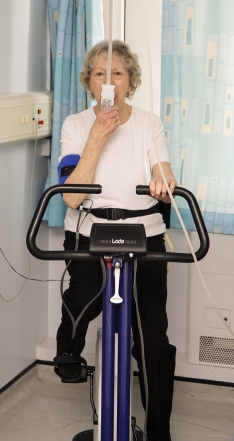Ask us a question?
Perioperative Care
Cardiopulmonary exercise testing (CPET)
 Cardiopulmonary exercise testing (CPET) was first used clinically in the 1980’s when it was shown that heart failure severity could be classified. It wasn’t until a decade later that its potential use in perioperative medicine was identified, when it was noted that there was a relationship between CPET results and perioperative mortality.
Cardiopulmonary exercise testing (CPET) was first used clinically in the 1980’s when it was shown that heart failure severity could be classified. It wasn’t until a decade later that its potential use in perioperative medicine was identified, when it was noted that there was a relationship between CPET results and perioperative mortality.
The physiology behind cardiopulmonary exercise testing (CPET) examines the response of the body to increasing intensity of exercise. Essentially it examines how the heart and lungs work together to increase oxygen consumption and carbon dioxide production during the increasing demand of exercise.
Traditionally CPET is conducted on a cycle ergometer which can increase resistance in a stepwise manner during the test. The patient is connected to a 12 lead ECG and a mouth piece analyses breath by breath oxygen consumption and carbon dioxide production. There is a short period of unloaded cycling (where there is no increase in resistance) followed by a ramping stage where a gradually increasing resistance is added to the flywheel at a work rate of between 10 and 20 watts. During this important phase of the test most of the information is received. This ramping phase usually lasts around 10 minutes after which the patient will have achieved a peak oxygen consumption known as VO2 peak. A final recovery phase is then performed where the resistance is reduced and the test is terminated.
During exercise, aerobic metabolism generates ATP (energy substrate) and carbon dioxide from the metabolism of oxygen and glucose. As the intensity of exercise increases there comes a point at which the body can no longer generate sufficient ATP from aerobic metabolism alone. Additional ATP is produced from anaerobic metabolism which involves the breakdown of glucose without oxygen with lactic acid produced as a by-product. Lactic acid is buffered to produce carbon dioxide and water. There is therefore a point during a CPET where CO2 production increases at an escalated rate. This point is known as the anaerobic threshold (AT) and is defined as O2 uptake in ml/kg/min.
Increasingly, along with anaerobic threshold we are looking more closely at other CPET values to improve our risk stratification of patients prior to high risk surgery. Of particular importance is the ventilatory equivalent for CO2 which describes the relationship between minute ventilation and carbon dioxide production. An elevated value is associated with poorer surgical outcomes and is often seen in heart failure and patients with respiratory disease.
In health, cardiac output is dependent on an individual’s heart rate and stroke volume (the amount of blood ejected per beat). As exercise intensity progresses you would expect both heart rate and stroke volume to increase. On a CPET it is possible to determine whether a patient’s heart is pumping efficiently and is managing to increase stroke volume in line with heart rate. A reduction in this variable may indicate a degree of myocardial dysfunction resulting in an increased perioperative risk.
At York, once a test is conducted a Consultant Anaesthetist analyses the results and sits down with the patient and their family. We discuss an individualised risk of morbidity and mortality based on the test results, which allows the patient to make an informed decision about their treatment. If the risks are felt to be too great we may recommend exploring alternatives to surgery. Otherwise, we identify any alterations in medication to modify this risk and determine the most appropriate perioperative care and postoperative location. More detail on how we stratify our patients according to their CPET results can be found on our Perioperative Stratification page.
General Recommendations
- Aim to perform CPET on all major elective patients over the age of 55 years.
- Assess whether surgery is the best option for an individual or whether alternative treatment options should be explored.
- If surgery is decided upon, determine the patient’s requirements for intraoperative monitoring and post-operative destination.

